Faculty and Staff
Click here to add your own text
In a recent survey of participants at the jane b semel HCI Community Garden, 55.6% of participants agreed that the garden increased their sense of community at UCLA. More than 50% agreed that the garden had inspired an increase in their consumption of fresh produce and 83% agreed or strongly agreed that participation increased their overall health. Gardening is known to not only encourage healthier eating habits and increase food security, but also provide a variety of surprising health benefits, including decreased risk of stroke, Alzheimer’s, and depression, as detailed in this article by Robin Jacobs.
In 2015, the student club Dig: The Campus Garden Coalition at UCLA was inspired by these benefits and joys of gardening. Supported by the Semel HCI Center and its founder and visionary Jane B. Semel, Dig students designed the jane b semel HCI Community Garden at the Sunset Canyon Recreation Center. Dig has existed since long before the creation of the garden as the main student-led collaboration behind the expanding food growing and gardening program on UCLA’s campus. Now, the garden’s 31 beds are used for academic courses, by student organizations, and by small groups of students, staff, and faculty. For anyone interested in applying for a plot, all that is needed is a group of at least five UCLA affiliates with a shared desire to grow your own produce, then head to the garden’s website and select the “How to Join” tab.
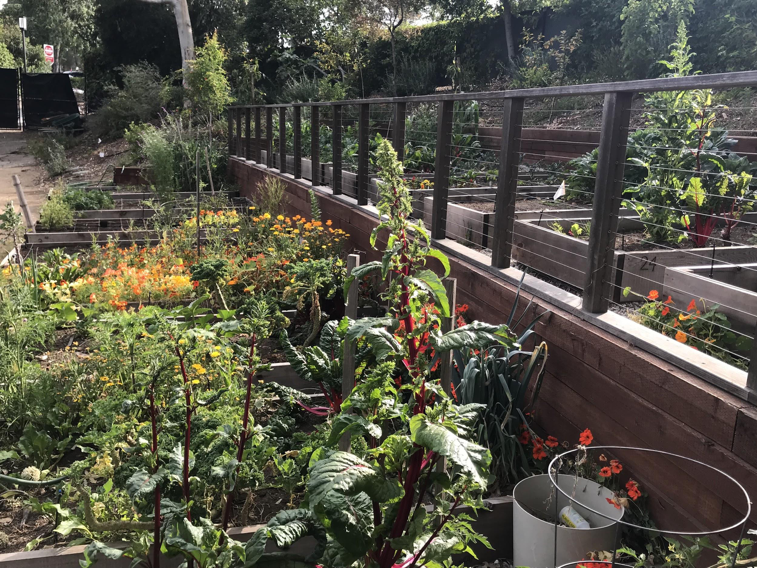
The jane b semel HCI Community Garden.
In alignment with one of the garden’s original goals to educate UCLA students, staff, and faculty, the garden began to hold workshops and general workdays in 2016. At the beginning of the program, workdays were casual, but they became more structured as the garden expanded. The Urban Gardening Certificate Program (UGCP) was later created due to astounding demand for the academic course CHS (Community Health Sciences) 131: Healthy Food Access in Los Angeles.
The UGCP is a free, flexible program recognizing a participant’s commitment to attending a series of workshops and events geared towards building fundamental knowledge of gardening. A collection of 5 workshops are held throughout the quarter, on topics such as growing methods, orchard culture, integrative pest management, soil health, and processing. Participants are awarded the certificate upon attending one workshop of each category and completing a few additional requirements detailed in the image below. For the program pilot, these five workshops are offered during both each winter and spring quarter, so if you’re unable to attend one in winter quarter, you can attend during the spring instead!

More information on the UGCP.

Examining the carbonation and SCOBY at a recent workshop on fermentation.

Making sauerkraut at a recent fermentation workshop.
To learn more about the jane b semel HCI Community Garden:
Facebook: https://www.facebook.com/groups/amphitheatergarden
Instagram: @HCIgardens
Email: hcigardens@ucla.edu
Sign up for the mailing list here! https://ucla.us18.list-manage.com/subscribe?u=23cc009df9eb0fd1d338f2b6d&id=8445a6df09
See the Winter 2019 Newsletter below:
Patience Olsen is an undergraduate student at UCLA majoring in Civil Engineering. In addition to blogging for the EatWell Pod, she volunteers at the Mildred E. Mathias Botanical Garden on campus, and is a member of the ASCE Environmental Design project.
Have you noticed a transition in the snacks and beverages offered in vending machines on campus? What about those “healthier choices made easy” stickers on the outside of the machine and “EatWell” stickers on individual snacks? Did you know that healthier snacks have been strategically placed closer to eye-level? Each of these changes has been deliberately implemented over the past few years by the UC Healthy Vending Working Group (UC HVWG).
Some background on the UC HVWG: The Global Food Initiative (GFI), launched in 2014, utilizes the University of California’s power of research and extension in an effort to create and execute solutions for food security, health and sustainability. The UC HVWG was established as a GFI Project to ensure that all UC campuses provide access to nutritious snacks and beverages. To achieve this objective, the UC HVWG created a set of guidelines that outline the minimum requirements for healthy vending machines. One guideline, for example, dictates that all healthy food items must “have a fruit, vegetable, low-fat dairy, protein (including nuts and seeds), or whole grain as its first ingredient.”
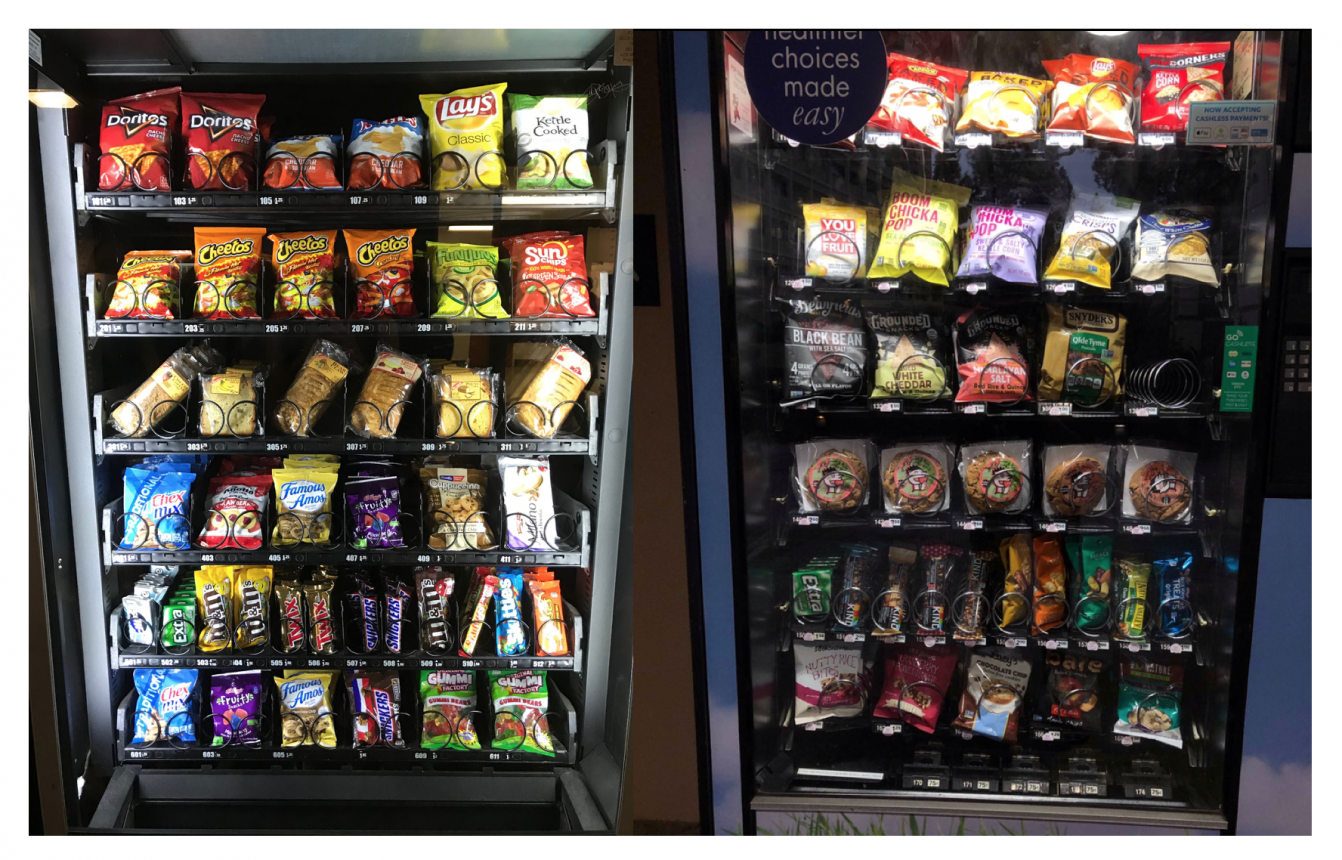
A comparison of a traditional vending machine and a healthier vending machine at UCLA. Located at the Mathematical Sciences Building and the mailroom on the Hill, respectively.
According to these guidelines, all healthy beverages such as water, juice, milk, non-dairy milk, protein drinks, and tea/coffee must contain no added caloric sweeteners. “Low-calorie” beverages are permitted to contain added sugar if they contain fewer than 40 calories per 12 fluid ounces. Healthy snacks must contain no more than 250 calories, no trans fat, no more than 10 grams of fat, no more than 3 grams of saturated fat, no more than 360 milligrams of sodium, and no more than 20 grams of total sugar.
There are a few exceptions to these rules, including nuts, legumes, eggs, cheese, fruits/vegetables, and combinations of these items (e.g., a fruit and nut mix). Notice that all of these exceptions are whole foods, meaning foods that have undergone minimal processing and look as close as possible to the way they look when growing in nature. In general, whole foods are exempt from all requirements except the calorie and sodium requirements, as long as they don’t contain added sweeteners or fat!
Research reveals that “the adult population in the United States as a whole is deficient in certain micronutrients as a result of the availability and overconsumption of high-calorie, low-nutrient processed foods.” (Astrup and Bugle, 2019) In general, highly processed foods contain empty calories and have a much poorer nutrient profile than their unprocessed counterparts. The UC HVWG therefore targets these nutrient deficiencies and the consumption of empty calories by encouraging the consumption of whole foods instead.
At UCLA, the Semel HCI Center ensures that 50% of snacks in healthier vending machines follow UC Healthy Vending Working Group guidelines. But many machines go above and beyond! UCLA Dining Services currently operates a total of 105 snack vending machines, 100 of which follow the 50% healthy rule, and 14 of which are filled 100% with healthy snacks.
The UCLA campus is also home to 215 beverage vending machines, of which 107 beverage machines are “zero sugar”. The remaining 108 are “reduced sugar”. Zero sugar machines are located at Housing on the Hill, the Ronald Reagan Medical Center, and the Santa Monica Medical Center.
As Charles Wilcots, Associate Director of UCLA Dining Services reports, “We anticipate to increase more vending selections to offer healthier options in the near future as we get more available products. Our overall goal is for all vending machines in our inventory to comply with the GFI criteria.” With a total of 320 vending machines, and only 5 snack machines left to make the switch to the healthy vending guidelines, UCLA Dining Services is already 98% compliant with UC HVWG criteria!
There is inevitably much more to encouraging healthy choices than simply providing healthy options. Within the 50% healthy vending machines, the challenge then becomes ensuring that consumers choose from the healthier 50%. The UC HVWG employs a few key psychological tactics: placing healthy products at eye level, advertising healthy beverages on beautiful vending machine wraps featuring a background of green grass and blue skies, and decreasing the price of healthier products, while increasing the price of unhealthy products. In a study by French and colleagues (2010), the proportion of healthy to unhealthy items in vending machines was increased to 50% healthy items and 50% unhealthy items. When prices of healthy items were lowered by an average of 31%, sales of healthy items increased by up to 42%. Because who wouldn’t rather choose the cheaper (and healthier!) snack?
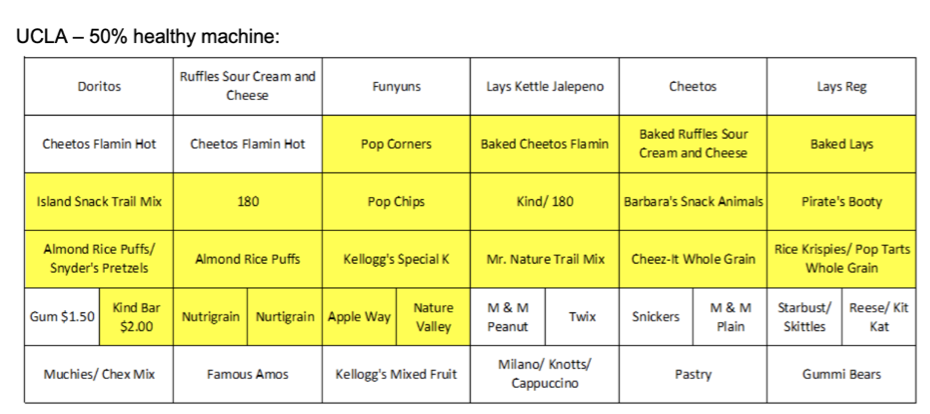
Six sample plans for UCLA vending machines. Snacks in yellow are designated “healthy snacks”, and stocked at eye-level.
It’s fair to ask whether any of this is actually profitable. Healthier snacks at grocery stores are generally more expensive than highly-processed, large-scale manufactured snacks. Wouldn’t it follow that reducing the prices of expensive healthy snacks in vending machines decreases profit? A study by Viana and colleagues (2017) at UCLA found this assumption to be false.
In their research, two types of machines were compared: “intervention machines”, with 50% healthy options, and “comparison machines”, with a usual assortment of snacks (see pictures above). Viana and colleagues found that 21.3% of snacks purchased from intervention machines were healthy, whereas only 1.3% of snacks purchased from comparison machines were healthy. Since cost per item was increased from approximately $0.99 to $1.08 between 2012 and 2013, revenue was able to remain consistent. These findings suggest that “health-promoting interventions can influence vending machine consumers without compromising revenue or profit.” (Viana et al., 2017)
By strategically encouraging healthier snacking, the UC HVWG and the UCLA Semel HCI Center aims to “make the healthy choice the easy choice.” Unfortunately, supermarkets and food manufacturers may not always share this goal, so keep a careful eye out for foods marketed as healthy that are potentially not so great for you.
Viana, J; Leonard, S. A; Kitay, B; Ansel, D; Angelis, P; Slusser, W. (2017) “Healthier vending machines in a university setting: Effective and financially sustainable.” Appetite Vol. 121: 263-267. DOI: 10.1016/j.appet.2017.11.094
French, S.A; Hannan, P.J; Harnack, L.J; Mitchell, N.R; Toomey, T.L; Gerlach, A. (2010) “Pricing and availability intervention in vending machines at four bus garages.” Journal of Occupational and Environmental Medicine Vol. 52: S29-S33.
Astrup, A; Bugel, S. (2019) “Overfed but undernourished: recognizing nutritional inadequacies/deficiencies in patients with overweight or obesity” International Journal of Obesity Vol. 43, Iss. 2: 219-232 DOI: 10.1038/s41366-018-0143-9
Patience Olsen is an undergraduate student at UCLA majoring in Civil Engineering. In addition to blogging for the EatWell Pod, she volunteers at the Mildred E. Mathias Botanical Garden on campus, and is a member of the ASCE Environmental Design project.
As we ring in the New Year, I can’t help but think of sparkling wine and its progenitor: the grape. In fact, while we are on the subject of Champagne and sparkling wines, here are a few “did you know” facts you may find interesting. First, you can make sparkling wines from any grape or fermentable fruit. However, real Champagne only comes from the Champagne region of France. The two major gapes used in making Champagne are Chardonnay and Pinot Noir, while everything else is a sparkling wine. Also, 25% of all sparkling wine sales occur in December, so if you want a good deal, February is a great time to buy!
But enough about Champagne and wine. Let’s move on to grapes and some other “did you know” facts:
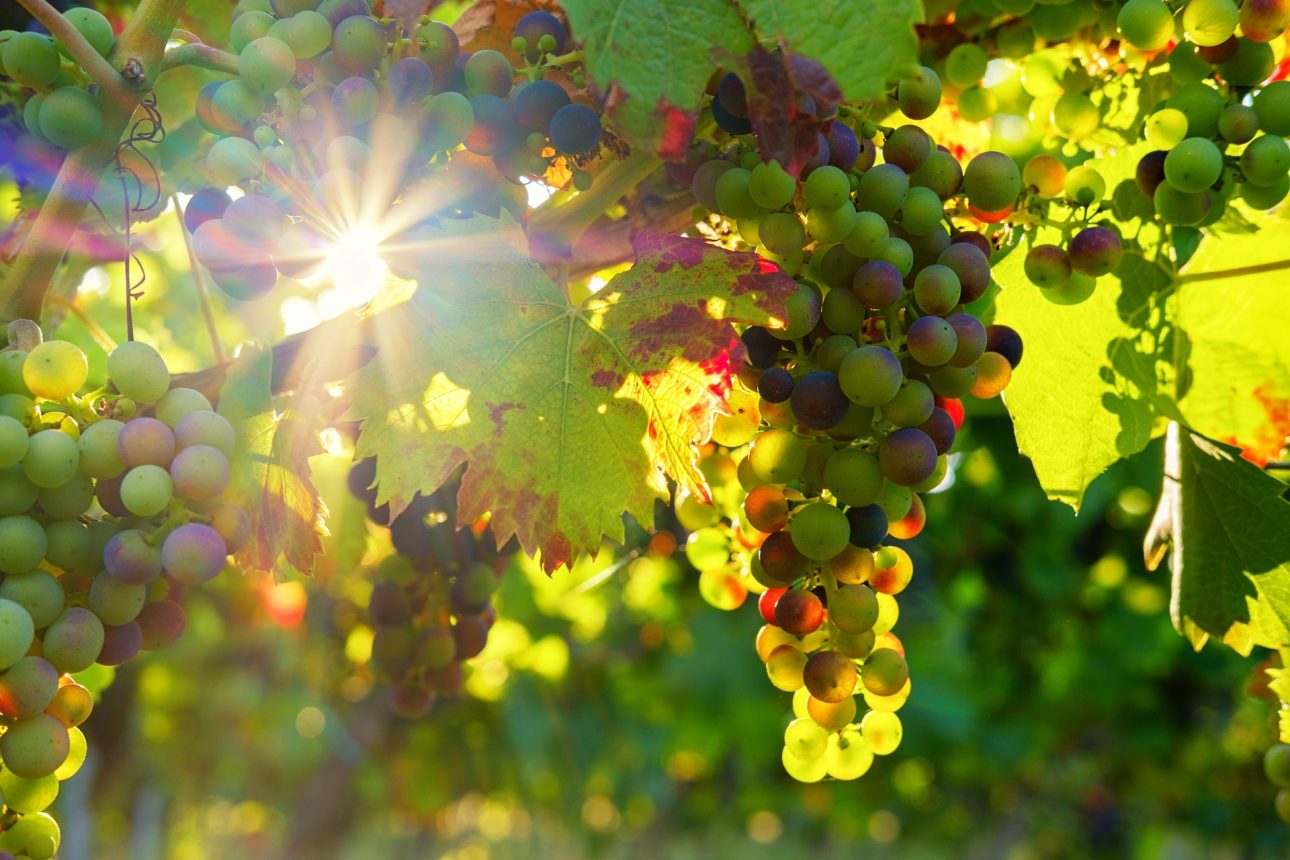
Have you ever wondered how many varieties of grapes exists? The answer might surprise you, as no one knows (and while researching, I found several different answers). The number is somewhere between 8,000 and 10,000 varieties of grapes in the world. Many of these varieties are new hybrids developed through grafting and other methods. Often, certain types of grapes are popular in certain countries.
Grapes are among the oldest cultivated fruits. Fossil evidence indicates grapes were consumed and possibly cultivated as early as 8,000 years ago near the Black and Caspian Seas. There are two major categories of grapes: Old World European (Vitis vinifera), mostly used for making wine, and New World, (Vitis labrusca), which are native to America and mostly used for eating. While we know Spanish settlers brought Old World grapes to California, we don’t know how the New World grapes got here. Grapes have a history in every country and in every civilization from the Egyptians to the Romans and Greeks. In fact, both the Romans and the
Greeks worshiped their own God of Wine, Bacchus in Rome and Dionysus in Greece.
Grapes are one of the most versatile fruits on the planet. They are great when fermented into adult beverages or made into a juice for kids. They can also be used as a natural sweetener and are a great substitute for refined sugar. A lesser known use is that grapes can substitute yeast as a natural starter for bread production. Grapes are delicious in jellies and jams or included in desserts. They enhance savory dishes, are excellent paired with cheese, and are refreshing when blended in a drink. Grapes can be frozen and eaten as a satisfying, healthy snack or just eaten in their fresh, natural state. Even the leaves can be eaten. If you feel adventurous, look up a few recipes for stuffed grape leaves, which are popular in the Middle East and Greece.
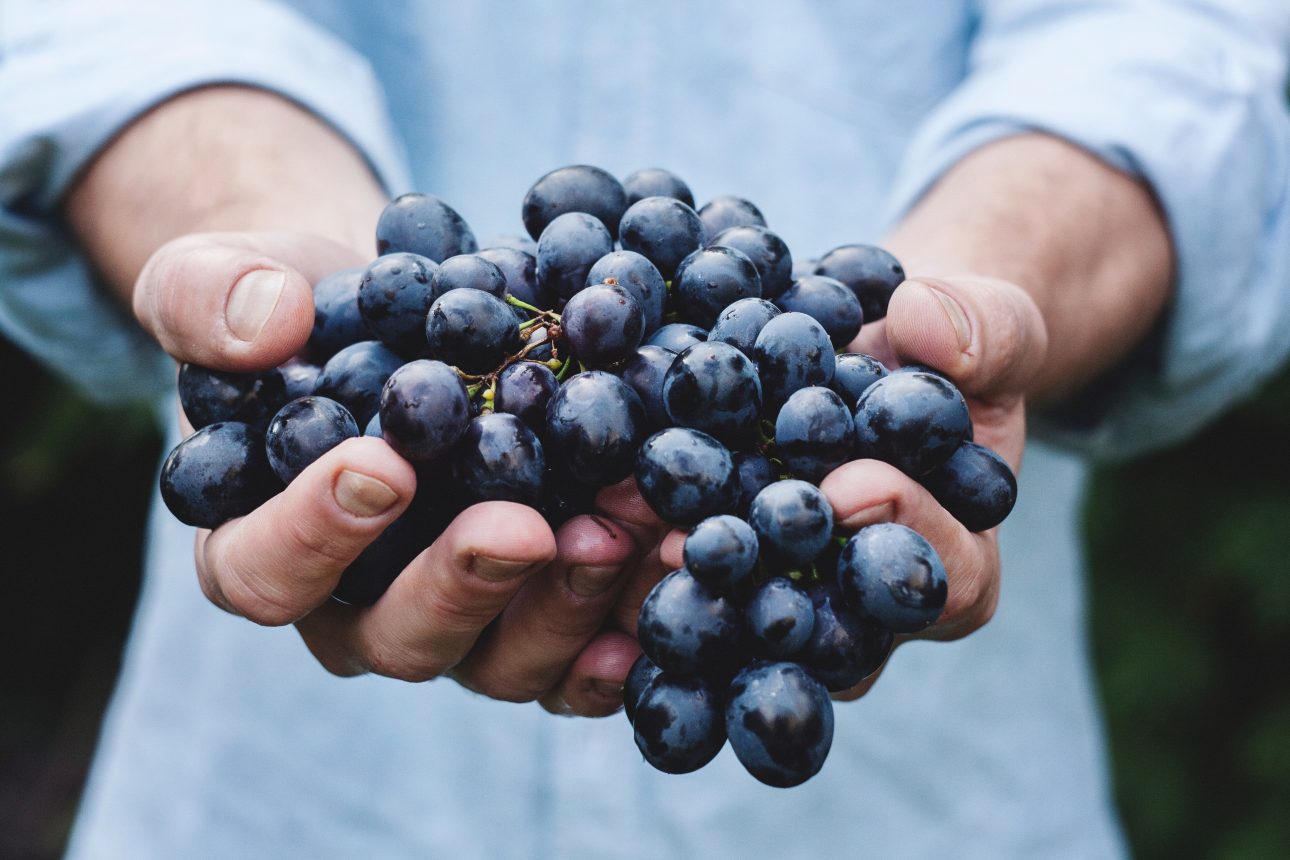
Most people go to a supermarket and buy either green or red grapes. BORING! – Especially for those of us who live in California where 97% of the US table grapes are grown. Did I mention there are thousands of varieties? Please go explore new varieties and break the green-and-red-grape-only buying habit. Stop picking grapes by color and instead choose them by name, or go out to local farms and explore different varieties. Just to name a few types of grapes there are Perlette, Thompson Seedless (which are found everywhere), Exotic, Flame Seedless, Ribier, Superior Seedless, Ruby Seedless, Emperor, Red Globe, Christmas Rose, Calmeria, and Concord. Every wine grape variety you can think of, from Chardonnay to Zinfandel, are all delicious to eat fresh as well.
Fresh grapes are not just delicious but also very healthy, containing natural sugars and essential nutrients. The most important nutrient in grapes is Vitamin C. Depending on the variety, ten grapes have approximately 5 mgs of Vitamin C. Also, grape skins, pulp, and seeds contain the antioxidant flavonoid resveratrol, one of the naturally occurring compounds in wines appears to lower cholesterol levels and reduce the risk of heart disease. Purple grape juice contains more of this antioxidant than red grape juice, which in turn contains more than white grape juice.
To put it simply, let’s celebrate grapes– either in a glass, by the handful, or from a box of raisins. Here is a recipe to get you started!
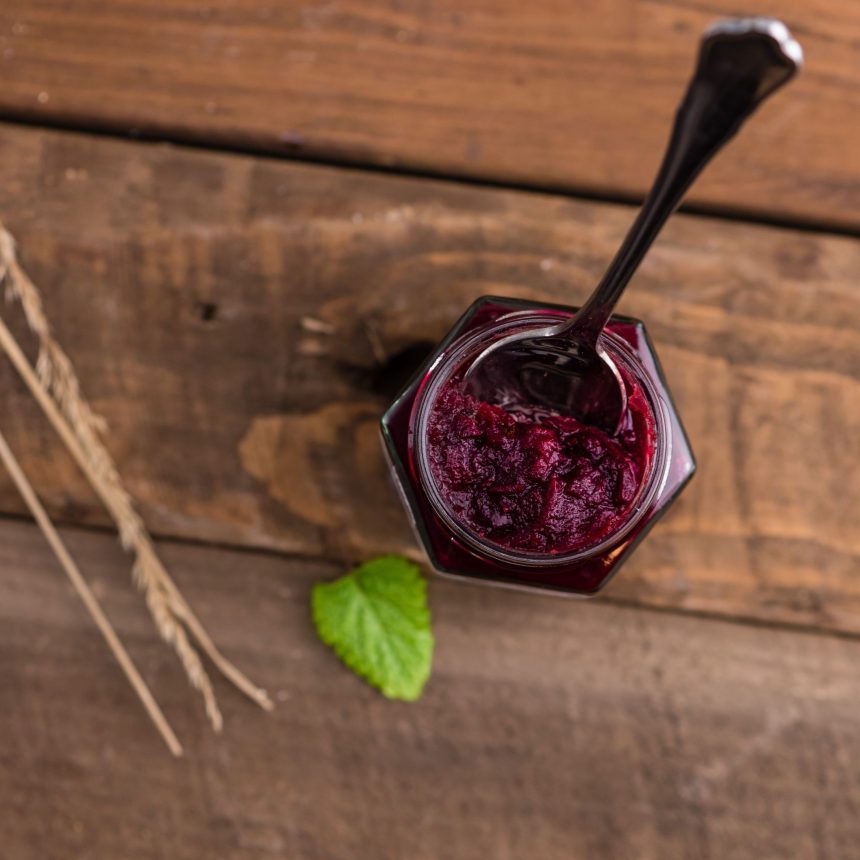
– Serves 4-6 –
(Great served with chicken or fish.)
1 Cup Green Seedless Grapes (sliced)
1 Cup Red Grapes (sliced)
1 Cup Black Seedless Grapes (sliced)
1 TBSP Vegetable Oil
1 Dried Chili Pepper
1/8 TSP Cumin Seeds
1/8 TSP Mustard Seeds
1/8 TSP Fennel Seeds
1/8 TSP Caraway Seeds
1/8 TSP Fresh Medium Ground Pepper
1 TSP Finely Minced Ginger
2 TBSP Lemon Juice
1 Cup Water
¼ Cup Agave
½ TSP Salt
Al Ferrone is the senior director of Food & Beverage at UCLA Housing & Hospitality Services. With extensive years of food and beverage/hotel experience, Al Ferrone manages all areas of F&B for UCLA including Dining Services, Lake Arrowhead Conference Center, the UCLA Meyer & Renee Luskin Conference Center, and UCLA Catering. Prior to UCLA as the Vice President of Food & Beverage, he played a significant role in the guidance of hotel and F&B strategies at Caesars Entertainment Corporation, Hilton, and Interstate Hotels Corporation. He has worked with a wide-ranging family of hotel and casino brands. He also developed and independently managed the Hilton Restaurant Group, which consisted of freestanding restaurants with over eight concepts.